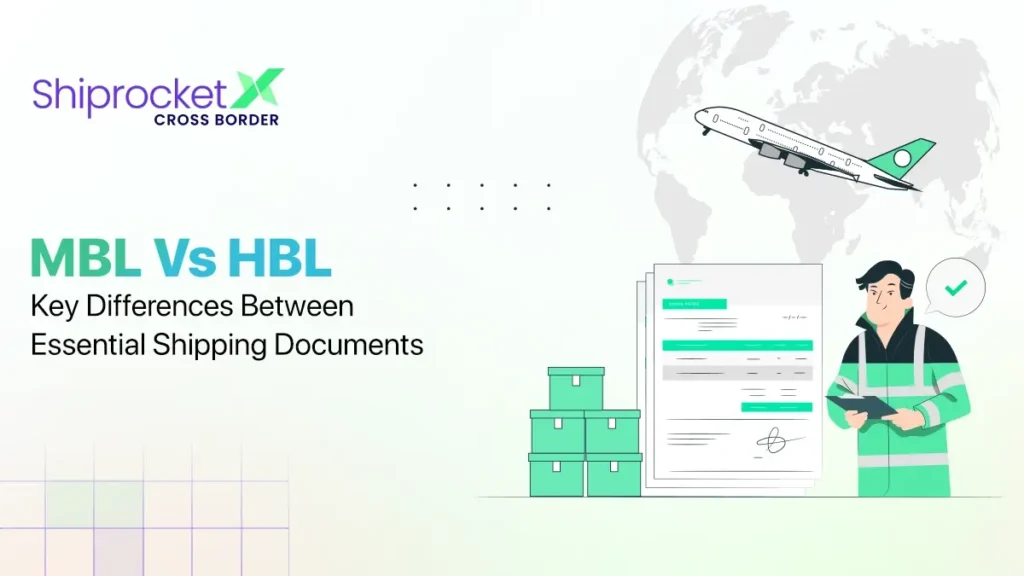Master Bill of Lading vs House Bill of Lading: Key Differences
The documentation involved in international shipping is extremely comprehensive. Such intense paperwork is bound to lead to confusion and complications. Do you, too, often confuse the master bill of lading (MBL) with the house bill of lading (HBL), and vice versa? The MBL and HBL are the two documents that are extremely crucial for the cross-border shipping of goods. They serve different purposes and include different components.
This blog highlights the major differences between MBL and HBL and the role of different parties involved in the international shipping process. The need for understanding the two documents is vital when you are a global trader. The components and processes included in MBL and HBL are also discussed in this blog.

Master Bill of Lading: What is it?
A master bill of lading (MBL) is a crucial shipping document provided by the company that owns the ship transporting the goods. The carrier provides such a contract for shipping parcels from one place to another. When you are working with a freight forwarding company or even a shipping company, they will provide you with an MBL. It will contain all the primary details like destination, sender and receiver details, the person in possession of the goods, and more. This document is extremely crucial for sea shipping. The shipping service provider or the freight forwarding firm will write, sign, and provide this document to the company that booked the shipment.
Consider an example, let us assume that there are three small businesses. The first in Delhi, the second in Mumbai, and the third in Chennai. All of these aim at exporting their goods to a business in the United States. The three companies will not be able to fill an entire container in one go. Thus, they connect with the same shipping company to consolidate their goods into one container for the overseas journey. The MBL will be issued by the shipping company to the seller or even their nominee. This will entail the overall consolidated shipment. The shipper will be the freight forwarder and the company in the United States will be the consignee. It also has the total goods quantity in the container having all the items from the three businesses.
Master Bill of Lading: Significance and Function
A master bill of lading plays a very important role in global trade. It clarifies who is responsible for what function, given instances of the shipping process. In the extremely intricate world of global trade, it can be quite challenging to figure out when the goods will belong to the importer or other parties. This is where the MBL document comes into the picture. It provides the answers to all of these questions along with a set of rules for who owns the goods and when.
Components of a Master Bill of Lading
The crucial information included in a master bill of lading is listed below:
- Consignor details
- Consignee details
- Container number
- Seals
- Item count
- Weights
Any MBL must possess all of these details clearly and accurately as it makes sure that the goods can be unloaded and discharged anywhere in the shipping process. Thus, it acts as an instruction manual that guides the entire delivery process.
Filling Out a Master Bill of Lading: Step-by-Step Process
Filling out an MBL document must be done with care and attention to detail. This is crucial as the information provided needs to be extremely precise. Here is a simple breakdown of all the necessary details that must be a part of MBL:
- Consignor details: The business name, address, and contact details of the shipper must be precisely mentioned.
- Consignee details: The business name, contact information, address, and tax ID details of the consignee must be mentioned.
- Information relevant to party notification: The business name, address, and contact details must be mentioned for the notified party.
- Shipper forwarder details: If there is a forwarding party included, you must add their name, address, contact details, and FMC number.
- Booking number: Carrier number, consignee, and cargo details must be added.
- Ports: The loading and discharging ports must be highlighted.
- Vessel and voyage: The voyage reference number enables tracking of the vessel and it must be added in the MBL. The name of the vessel must be indicated.
- Packing details: The exact piece count and type of package must be specified.
- Seal and container numbers: These unique codes are to be included on the MBL to enable easy traceability.
- Volume and weight: The weight and volume of the container must be added to the MBL.
- Cargo details: The counts of the components, weight, volume, etc., must be indicated.
- Additional details: the ITN (Internal Transaction Number) number, HS (harmonized System) code, payment terms, and BL release type details must be added.
House Bill of Lading (HBL): Definition
A house bill of lading (HBL) is a document that is issued by freight forwarders, the Customs House Agent (CHA), or the Non-Vessel Operating Common Carrier (NVOCC). Though the HBL is not legally enforceable, it’s linked to the master bill of lading. It acts as proof that goods have been received and are being dispatched. This document is given to the suppliers as they send out their cargo for shipment processes.
Let us consider the example of the three companies mentioned above. In that case, the house bill of lading is issued separately for every business by the freight forwarder. Each HBL document will specify the goods being shipped along with their quantity, destination location, shipper, and consignee.
What is the Role of House Bill of Lading
The primary purpose of a house bill of lading is to record the contract between the recipient and the carrier for shipping goods, after making sure that the packages are in good condition for transport.
Other purposes served by the house bill of lading are given below:
- It’s a formal acknowledgment of the receipt of the consignment in proper condition for shipment by the carrier.
- It prevents illegal transportation by acting as proof that the carrier has a valid contract to ship the cargo.
- It also guarantees the consignment is not damaged and is ready to be shipped to the consignee. Unless the house bill of lading otherwise specifies, any damage to the packages during shipping is the liability of the carrier.
- In case the recipient does not have the required documents for pickup at the destination, the house bill of lading gives the carrier the authority to retain custody of the cargo.
- It also ensures the carrier only releases goods to the legal recipient. In case of non-compliance, the house bill of lading creates a legal liability.
- The bill of lading number mentioned on the document also helps in tracking the house bill of lading.
Contents of a House Bill of Lading
The house bill of lading includes the following details:
- Exporter’s name and address
- The importer’s name and address
- Overall value of the goods
- Details of transportation
- Terms and conditions of the shipment
Filling a House Bill of Lading
You should include the following details when filling the house bill of lading.
- Shipper: The address and name of the shipment sender or the freight forwarder is mentioned.
- Consignee: The address and name of the cargo receiver are also highlighted. They will be responsible for any issues in the destination location including clearance of customs.
- Notify Party: Upon the arrival of cargo which parties are to be notified are also mentioned as these details can vary based on the B/L.
- Pre-carriage: The inland vessel details will also be mentioned, if any.
- Place of receipt: The area where the cargo was handed over to the carrier is also mentioned.
- Discharge port: The location where the vessel will be unloaded must be accurately mentioned.
- Delivery place: The final delivery location will also be highlighted on the HBL.
- Goods and package description: Whatever lies within the package must be described.
- Gross weight: The overall weight without the actual container itself must be mentioned.
- Measurement: The volume in cubic meters must be expressed.
- Tracking and identification numbers: These codes must be precisely mentioned on the HBL.
Conclusion
The two important documents, namely the master bill of lading and the house bill of lading in international trade are often used interchangeably without a proper understanding of their meaning and importance. The HBL serves as a receipt for a shipment from one exporter while the MLB is a receipt that covers multiple shipments through the consolidation of the carrier. The HBL is given to the non-vessel carrier party by the freight forwarder while the MBL is given by the carrier to the shipper. These documents act as an instruction manual during the entire shipping process making them extremely important.





